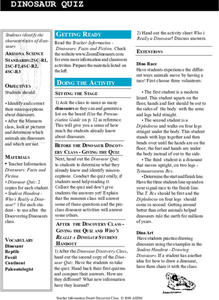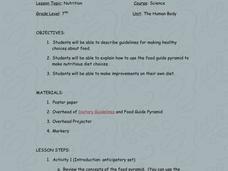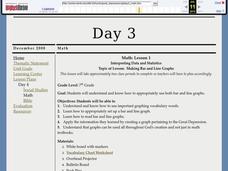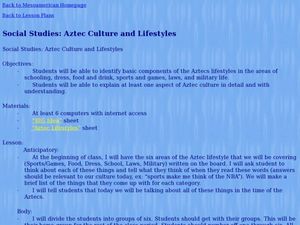Curated OER
Cause-Effect Fishbone Diagrams
In this cause and effect worksheet, students read about the cause/effect relationship and how to analyze using a fishbone diagram. Students are given a blank template of a diagram.
Desert Discoveries
Dinosaur Quiz
Young scientists explore the world of dinosaurs. They engage in a variety of activities designed to help correct misconceptions about dinosaurs, and which help them to determine which animals are dinosaurs and which are not. There is a...
Curated OER
Genetics and DNA
Students describe the structure of DNA and its components and can comprehend that real DNA and its cartoon representation are very different. They are able to link DNA to genetic make-up.
Curated OER
Rhythm, Math, Rhythm
Students play instruments in math class to learn the interconnectedness between math and music. In this math lesson, students subdivide a piece of music, clapping rhythms and charting rhythm patterns in the song. A guided discussion...
Curated OER
Acid Mine Drainage
Learners use cabbage, backing soda, cobblestones, and more to test the acid in the water. In this acid mine damage lesson plan, students complete 13 experiments to test and treat acid.
Curated OER
Navajo Weaving
Students explore the Navajo culture. In this Navajo Indians activity, students gain information about their weaving and dancing. Students note the patterns in the weaving. Students create a dance that corresponds with the patterns they...
Curated OER
Woodwind Instruments and Pitch
Young scholars explore musical pitch. For this cross curriculum musical instruments and "sound" physics lesson, students identify and describe common traits of woodwind instruments. Young scholars research "pitch" and what causes pitch...
Curated OER
Exploring Countries and Cultures
Fifth graders choose a country associated with a family member and research its location, government, language, economy, history, holidays, foods, sports, and famous people. They write to inform using this data and draw a map identifying...
Science 4 Inquiry
Temperature of Inner Planets
Mars, Earth, and Venus contain atmospheres that generate weather. Young scientists explore the temperature of inner planets. They create a model simulating the greenhouse effect before researching and answering guided questions to...
Science 4 Inquiry
An Investigative Look at Florida's Sinkholes
In May of 1981, the Winter Park Sinkhole in Florida first appeared and is now referred to as Lake Rose. Scholars learn about the causes of sinkholes through an inquiry project. Then, they analyze recent data and draw conclusions to...
Science 4 Inquiry
Carbon and Climate
The carbon cycle is natural and has happened for millions of years, so can humans change it? Young scientists play the role of carbon as they travel through the carbon cycle. They complete two rounds, once before the industrial...
Science 4 Inquiry
Phases of the Moon
The moon takes just over 27 days to orbit around Earth. Young scientists position themselves as the earth as they rotate around the sun and hold the moon. This allows them to observe the patterns and phases of the moon.
Science 4 Inquiry
Enzymes in Action
Enzymes play a role in almost every function in the human body. Scholars explore three variables related to the use of enzymes. They observe a catalase reaction, experiment with substrates, and examine reactions rates.
Science 4 Inquiry
States and Phases of Matter
Plasma is the most common phase of matter in our universe. Scholars explore the change of energy as molecules change phases of matter. They rotate through stations, graphing the changes in energy level.
Science 4 Inquiry
Trick or Science: Catching the Light
Your class might be surprised to learn that mirrors have been around since the first century AD! Young scientists explore reflection and refraction of light through a series of challenges. They use this knowledge to design their own...
Science 4 Inquiry
Let's Get Moving
Rivers top the list of causes of erosion over time. Scholars experiment with wind, water, and ice reshaping sand. They connect the simulations facts about erosion and deposition to understand unique landforms such as the Grand Canyon and...
Science 4 Inquiry
Maintaining Mass
Can you disprove the law of conservation of mass? Pupils observe the teacher weigh each part of a reaction. Then, the teacher weighs the result of the reaction and everyone sees that the products do not equal the reactants. Then they...
Curated OER
Greatness of Love
Seventh graders study encouragement and love toward others. In this bible lesson, 7th graders discuss practical ways people can show love to others. Students also recognize agape love as the highest form of loving expression as shown by...
Curated OER
Nutrition
Seventh graders describe the healthy choices about food. In this nutrition lesson, 7th graders use the food pyramid to help them in making nutritious choices. Students discuss their diet and talk about how it can be improved.
Curated OER
String Instruments and Pitch
Learners make predictions and explore how pitch is altered in string instruments. In this acoustic science lesson, students learn the types and parts of string instruments and create their own. They listen to classical music and identify...
Curated OER
Interpreting Data and Statistics
Students define terms and analyze data. In this statistics lesson, students plot their data using bar and line graphs. They analyze their data after they graph it and apply the results to the Great Depression.
Curated OER
Changing Bodies
Seventh graders listen to a poem about how a teen feels not understanding what is happening inside his body. For this health lesson, 7th graders label the endocrine glands and put sex characteristic cards in the order they think they...
Curated OER
Aztec Culture and Lifestyles
Students explore the lifestyles of the Aztecs. In this ancient culture lesson, students jigsaw into groups that divide up various aspects of Aztec culture. Students reform as a class in order to discuss and share their findings.
Curated OER
Mountain Creation: A Drama Exploration
Students explore mountain formation. In this cross curriculum earth science and legend writing lesson plan, students listen to the poem "The Way to make Perfect Mountains" by Byrd Baylor and identify examples of vivid language used....

























